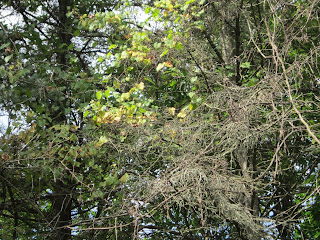Fall migration on the winds of the autumnal equinox
Today, 22 September, is the autumnal equinox. Twice each year, in spring and fall, the sun appears straight overhead at the equator. To us humans in the northern hemisphere, this means that our daylight is about equal to the length of our dark night on this day. Night will continue being a little bit longer each day until the winter solstice.
 |
| Philadelphia Vireos have been on the move lately. Photo credit: National Audubon Society |
Most smaller species of birds, especially warblers, vireos, tanagers, orioles and many thrush species migrate at night. The air is cooler then, and thus, is more stable. That makes it easier to fly when you weight only a few ounces. Cool nights when the air aloft is quiet make for good conditions in which to migrate. Birders definitely pay attention to bird migration when those conditions exist.
I was out paying attention today. Yesterday was typical of late summer -- hot and humid, but it cooled off nicely last night. This morning dawned to a thick fog. I could hear chips and seeps outside even before I got out of bed. I was anxious to get outside and see what migrants (also known as "eye-candy" to at least some birders) had come down through the fog and landed in my yard, fields and woods to refuel after a night of travel. But, I had to first make sure my teenagers got up, ate, and made it to the school bus on time.
 |
| Feeding stations, water sources, flowering plants, and even standing dead trees make an attractive stop-over site for migrating birds. Photo credit: Jody Enck. |
It was almost 8:30 until I got my morning chores done and got outside to see what "eye-candy" had appeared overnight. It was still very foggy and calm. The temperature was about 60 degrees F. I could hear plenty of birds, but the fog made it difficult to see them at first. Luckily, there is good habitat for hungry birds around my place. I quickly walked past my feeder garden with just a quick glance to see if any birds were using the water bath.
I headed to the corner of the yard where I can look over the split-rail fence into an old, over-grown area. This is an area with lots of wild flowers, young, shrubby plants, and some brush piles. This year, the wild grapes, crab apples and viburnums are heavy with fruit, too, which act as additional attractions for migrants.
 |
| The brushy corner of my yard after the fog lifted. Plenty of food and cover here to attract birds and insects. Photo credit: Jody Enck. |
I spied both Philadelphia and Red-eyed Vireos feeding there. A mixed flock of resident birds (Black-capped Chickadees, Tufted Titmice, White-breasted Nuthatches, and Downy Woodpeckers) also were working the area. As often happens, all this frenzy also included some of the "eye-candy" warblers I was after.
Black-throated Green Warblers were interspersed with Magnolia Warblers. Northern Parulas, with their spiffy blue heads, green backs, and brilliantly-colored breasts sparkled even in the fog. More subtlety-hued, female Common Yellow-throats, Tennessee Warblers and Nashville Warblers also were in this group.
Short-distant migrants also were around today.
I counted some Mourning Doves, Song Sparrows, mewing Gray Catbirds, and an immature male Yellow-bellied Sapsucker on my walk. My yard is not huge, but it does have lots of nice bird habitat. In the back, there are some White Spruce and Norway Spruce trees with lots of small cones this year. Many of those trees also are covered in hanging Virginia Creeper and Wild Grape. Insects like the fruit, too. So birds, are attracted to these areas for both the fruit and for the insects.
 |
| The wild grapes and Virginia creeper berries hanging on my spruce trees also attract birds in good numbers. Photo credit: Jody Enck |
I wouldn't call this a red-letter day in terms of fall migration. Still, nearly two dozen species of birds in my little backyard is not too shabby either.
 |
| Hard to say that Nashville Warbler isn't "eye-candy," but it is more subtle in coloration compared to some of the warblers I spied today. Photo credit: Wikimedia commons. |
No comments:
Post a Comment